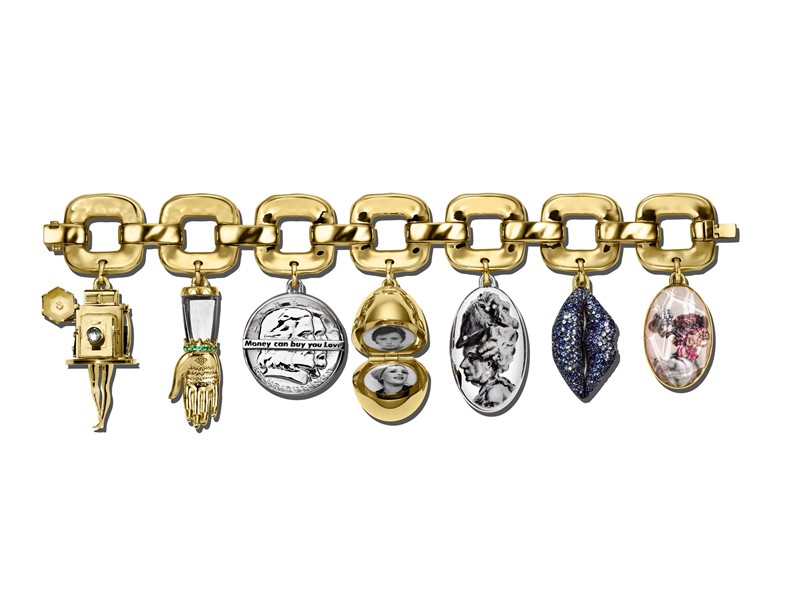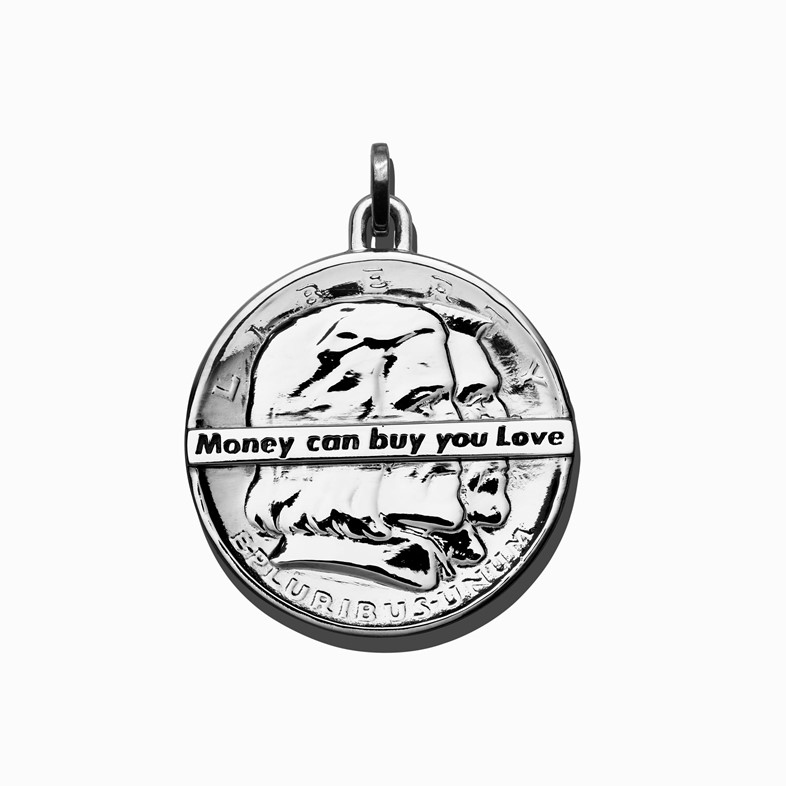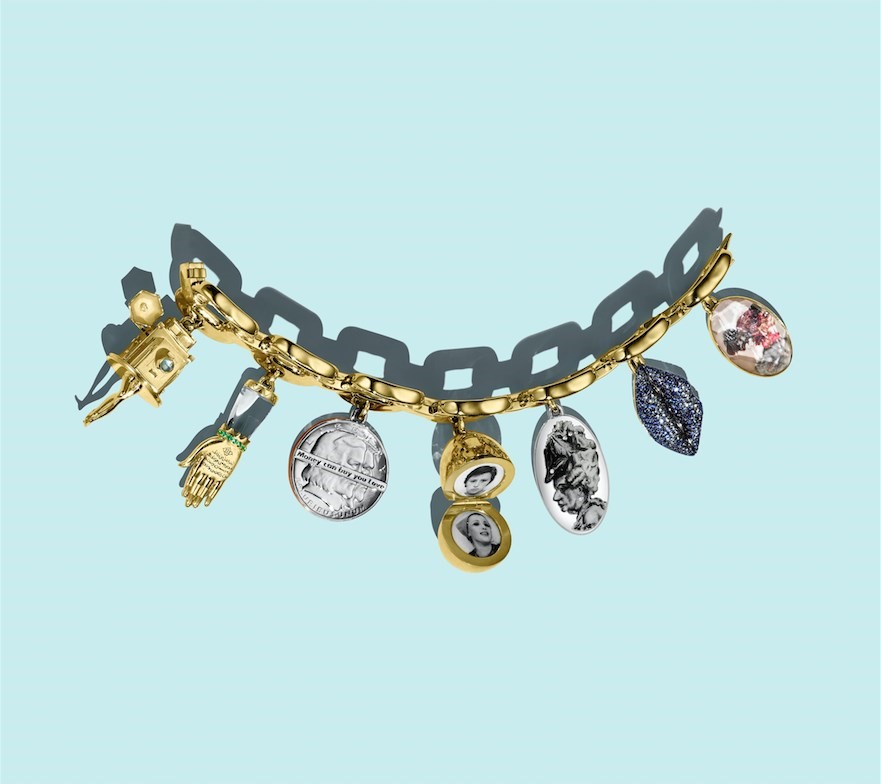Laurie Simmons, Rachel Feinstein and Liz Swig reflect on their most recent collaborative project: the ultimate piece of wearable art, which includes work from the likes of Cindy Sherman, Barbara Kruger and Wangechi Mutu
The clink of a charm bracelet is a familiar sound for generations of women. Traditionally, charms were acquired at a landmark moment in one’s life: a significant birthday, a first trip to Europe, a birth or a marriage, or simply a loved one returning from their travels. In such a sense, each charm is imbued with a memory – and each clink is a pertinent reminder of just how all of those memories sit alongside one another. Charmed, a new collaboration between Italian-born jeweller Ippolita Rostagno and Liz Swig, a New York-based art collector with a vision to unite artists with relevant brands, has put seven of the most important female artists working today at the forefront of a single piece of jewellery. Laurie Simmons, Shirin Neshat, Barbara Kruger, Cindy Sherman, Rachel Feinstein, Mickalene Thomas, and Wangechi Mutu have each designed a charm which has been crafted by Rostagno and sit on a single bracelet, placing their voices alongside one another with a mutual material to convey their ideas.
Laurie Simmons has created a gold camera on legs with a diamond lens, as a tribute to Jimmy the Camera (1987), an artwork by photographer Jimmy De Sana, who died of AIDS-related illness in 1990. Iranian-born artist Shirin Neshat created an emerald-embellished hand inscribed with Farsi text. Barbara Kruger continued to explore themes of consumerism and confrontational text with a silver coin that reads ‘MONEY CAN BUY YOU LOVE’. Cindy Sherman, on the other hand, chose to create a golden egg with portraits inside to represent fertility and femininity, while sculptor Rachel Feinstein, known for her fanciful aesthetic, turned one of her 18th-century Old Lady portraits into a diamond-dotted oval of enamelled mirror. For her part, Mickalene Thomas drew on the dazzling lips motif which is seen throughout her work to create a glittering sapphire-smothered pout, and Kenyan-born artist Wangechi Mutu explored the “complexity of being an immigrant – albeit one with visibility and voice,” by encasing her 2010 collage Pretty Double-Headed in a stone-faceted locket.

The result is a mesmerising collaboration which is a refreshing antidote to the bastardisation of artworks and art references in the fashion world. “We know there is art and we know there are brands and there are collaborations and all of these things exist but how do you put them together in a new, fresh smart synergy and dialogue?” is the question Liz Swig asked herself when she launched LizWorks, a platform for artist-brand collaboration, in 2014. She has previously lured Jeff Koons into designing dinnerware and persuaded Hiroshi Sugimoto to turn his vision to eyewear. Having been an influential art collector and hailed from a family of similar sorts, Swig is somewhat of a matchmaking patroness. “I have been referred to as that, although I don’t take a fee when people go get laid,” she laughs. “It’s more than that. I come up with a concept and an idea and then it’s like making a cake.”
One can imagine that getting the brands on board is the easy part – what brand doesn’t want an art world connection? – but surely artists must be sceptical of the explicitly commercial connotations of such collaborations? “Listen, if they don’t want to do it, they don’t do it,” Swig retorts. “If they are signing on to do it, I don’t know if they see it as pure product, because it isn’t. This is a new medium of true artworks – they’re wearable, they’re liveable, they’re usable, and they’re truly museum pieces.” Her work, Swig insists, is about ideas and utilizing the connections from her days spent collecting and sitting on the acquisition boards of museums to orchestrate collaborations that are authentic. “There was one day I was just thinking that charm bracelets were this forgotten fabulous thing for female history and storytelling and importance,” she explains. “Every little girl loved a charm bracelet and every mother had one and passed it down or got it from her mother. There was a real importance to the charm. What a cool thing to acknowledge its importance through these women.”

“I’ve always loved the sentimentality and femininity of wearing a charm bracelet,” says Rachel Feinstein, who was incidentally shopping for charms with her daughter when Swig approached her about the project. “My own mother and grandmothers did not wear jewellery and I don’t wear jewellery every day but somehow I became aware of charm bracelets as a young girl just like my own young daughter recently has. Flora wanted to go shopping for her seventh birthday in April. It instantly brought me back to my own childhood.” Simmons was similarly enamoured by the sentimentality of the object. “My mother wore a charm bracelet that told the story of her life. My father bought her a charm for every occasion—anniversaries, birthdays, and holidays— until the bracelet was filled,” she explains. “We used to take out the bracelet and play with it for hours. Twenty years ago I photographed my mother’s charm bracelet with a macro lens so I could remember every detail. When I was asked to make a charm it wasn’t a question of ‘What will I make?’ it was 'Which charm shall I make?’ because I’ve thought about creating a charm bracelet for a very long time.”
Swig says that what makes the bracelet so unique is that each of these artists’ works sits together – and Simmons agrees. “We love the idea of this charm in the context of all the other charms made by some of my favourite artists and close friends,” says Simmons. The bracelet will be kept to a limited production, with only 50 available on Ippolita, albeit at the steep price of $58,000. Then again, it isn’t just any bracelet we’re talking about – it’s a piece of art.
